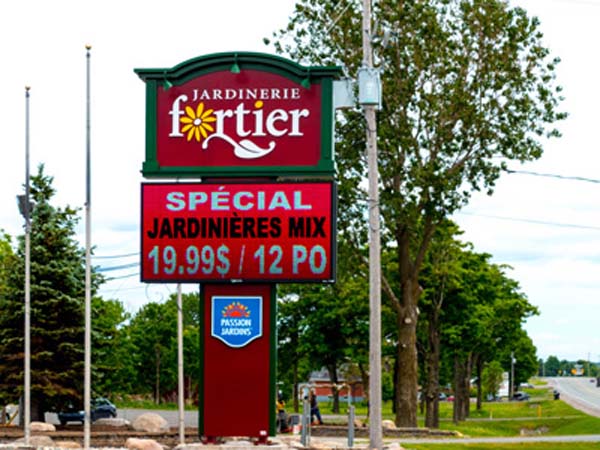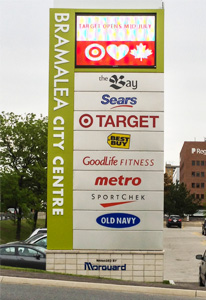Digital Signage: Choosing the right LED display
by all | 31 October 2014 12:30 pm
 [1]By Robert Blyth
[1]By Robert Blyth
The light-emitting diode (LED) display industry is converging today toward tighter pixel pitches in the interest of achieving greater resolution, such that 20-, 28- and 34-mm (0.8-, 1.1- and 1.3-in.) pitches now seem much less appealing than in the past. After all, a business owner looking for a sign may wonder, how could a 20-mm pitch be better than a 10-mm (0.4-in.) pitch?
Specifying the right display for the right application, however, involves debunking the hype for ever-tighter screen resolutions, which are not necessarily the right answer simply because they represent the latest technology.
Each LED display has a specific purpose. Sign customers need to be properly advised of the facts so they can make value-based economic decisions.
Limitations of tighter pitches
The International Sign Association’s (ISA’s) 2014 International Sign Expo provided a glimpse of the future with a 1.2-mm (0.05) pixel pitch display. The screen resolution was impressive. Standing only a few feet away, one could easily be convinced one was looking at a very large plasma screen.

Some LED displays need to be visible to drivers far away, while others are intended for pedestrians in closer vicinity.
Yet, the technology was not without its drawbacks. There were significant fluctuations in colour from one side of the display to the other, for example, and the longevity of the screen was rated for only three years with a maximum luminance output of 2,500 candelas per square metre (cd/m2).
As a result, this very expensive screen could only be used indoors and for a limited period. In the commercial sign industry, however, LED displays need to be installed outdoors to serve as electronic message centres (EMCs)—and customers have a limited budget.
Calculating viewing distance
Factory representatives commonly raise the issue of what pixel pitch is right for the sign’s height on a pole or wall, but the real deciding factor is the ideal ‘true viewing distance’ (TVD). This can be calculated through simple right-angle trigonometry based on both the height of the sign and the horizontal distance to the viewer (see Figure 1). In many cases, a greater installation height has only a negligible effect on TVD and thus no bearing on determining the ideal pixel pitch for the display.
Increased height can mean increased visibility, to a certain extent, but this has more to do with standing out from visual pollution than with pixel pitch. In most cases, after all, the display is intended to be seen from as far away as possible, to allow maximum time to achieve impressions on passersby for advertised products and services.
Local context
It is also important to take the sign’s specific purpose and location into consideration. Will it be displaying text, animation, still graphics and/or video? Where will most of the display’s audience be and how fast will they be travelling? If there is a stoplight nearby, that may be the ideal ‘marker’ to use as the estimated viewing distance line.

The size and resolution of the display will also depend on the nature of its content. Many LED boards are still dedicated to simple, monochrome messaging.
Pylon space, permits and, of course, the customer’s budget will also affect the size of the chosen display. While many customers want the highest-resolution display possible, that is not necessarily what they need, given the circumstances of their location.
By way of example, one can consider the two displays listed in Table 1, which carry the same cost of approximately $70,000, but are different sizes. At 12.5 m2 (135 sf), the 20-mm pitch display is 170 per cent larger than the 10-mm pitch display at m2 (50 sf), even though the 10-mm display has 41 per cent more pixels: 39,168 versus 27,648.
So, if a customer had that budget of roughly $70,000, he/she could choose an LED display with a 10-mm pixel pitch and minimum character height of 71 mm (2.8 in.) or a larger model with a 20-mm pixel pitch and minimum character height of 140 mm (5.5 in.). Every additional 25 mm (1 in.) of letter size adds 15 m (50 ft) of legible viewing distance.
If highway drivers are passing the sign at an average of 97 km/h (60 mph), the display with the 20-mm pitch enjoys an advantage of 27.5 seconds more viewing time, due to its 80 per cent greater viewing distance. To achieve the same effectiveness, the 10-mm pitch display would have to be significantly larger, bringing its cost close to $200,000.
A matter of math
This is why it is always better and easier to show customers through simple math which display will be the most cost-effective for their needs, rather than rely on hype or factory representatives’ technical presentations. And in the end, selling the right display to the user is the best way to ensure he/she remains a loyal customer in the future. As always, the sign industry’s growth depends on integrity.
Robert Blyth is a senior technical advisor for Optec Displays in St. Hubert, Que. For more information, visit www.optec.com[2].
- [Image]: http://www.signmedia.ca/wp-content/uploads/2014/10/crop35.jpg
- www.optec.com: http://www.optec.com
Source URL: https://www.signmedia.ca/digital-signage-choosing-the-right-led-display/